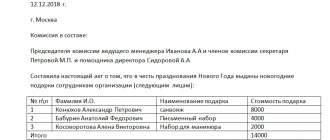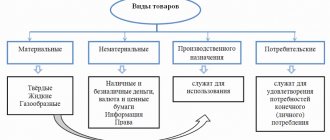VAT: inventory
It is known that before preparing reports for the next financial year, it is necessary to conduct an inventory of property and liabilities. This responsibility established by the Accounting Law is often neglected in the belief that no negative consequences will occur. However, conducting an inventory of receivables and payables as of December 31, 2007 will not only help confirm the indicators of the financial statements lines, but also monitor the correct completion of the transition period for VAT introduced by Law No. 119-FZ.
T.K. Yulina Let us recall that it was this law that was introduced into Chapter. 21 “VAT” of the Tax Code of the Russian Federation two truly revolutionary innovations:
– it is allowed to claim for deduction the amount of “input” VAT without waiting for payment for purchased inventory items (works, services, property rights);
– it is prohibited to charge VAT for payment to the budget using the “on payment” method, that is, after repayment of debt by buyers of products (works, services, property rights).
In connection with the introduction of new rules for taxpayers’ settlements with the budget, the legislator provided in Art. 2 and 3 of Law No. 119-FZ transitional provisions valid from 01/01/2006 to 01/01/2008. This law brought the least trouble to those organizations that determined the tax base using the “shipment” method. Their procedure for calculating VAT has not changed. Moreover, in accordance with Part 10 of Art. 2 of Law No. 119-FZ , they made deductions for the amounts of tax not paid upon the acquisition of goods (work, services), property rights that they accepted for accounting before January 1, 2006, in the first half of 2006 in equal shares. If the company did not construct facilities (for its own needs or for sale), then the transition period for the accountant has long ended, so he does not need to study the rules for its completion. They are established only for those taxpayers who:
– paid VAT to the budget as payment for goods sold (work, services, property rights) is received;
– had unfinished construction projects on their balance sheet as of January 1, 2006.
Let us analyze the nuances of the transition period for the first of the named taxpayers.
"Old" debts...
... This is how we will refer to accounts receivable and payable that organizations incurred before 01/01/2006. So, if as of December 31, 2007, there are no such debts on the company’s balance sheet, it means that the transition to the new rules for settlements with the budget for VAT is completely completed and in the first tax period of 2008 the tax is paid in accordance with the generally established Chapter. 21 “VAT” of the Tax Code of the Russian Federation in order (additional calculations and postings on accounting accounts are not necessary).
If during the transition period the “old” receivables were not repaid by buyers, then in the first quarter of 2008 they increase the tax base. It turns out that VAT on this amount, if it is not repaid in the future, is paid from the organization’s funds. Thus, in the first tax period of 2008, the balance of “deferred” VAT on account 76 will be closed.
For your information : when writing off receivables with an expired statute of limitations, they are taken into account for profit tax purposes in non-operating expenses of the organization, including the amount of VAT ( letter of the Ministry of Finance of the Russian Federation dated October 7, 2004 No. 03-03-01-04/1/68 , Federal Tax Service for the city Moscow dated 06/05/2007 No. 20-12/052920 , Decision of the Constitutional Court dated 05/12/2005 No. 167-O , Resolution of the FAS Central District dated 03/20/2006 No. A09-19604/04-12 , etc.)4.
At the same time, by virtue of clause 9 of Art. 2 of Law No. 119-FZ, an accountant has the right to include in tax deductions VAT on the amount of “old” accounts payable (for purchased goods, work, services, property rights capitalized before 01/01/2006). During the transition period, deductions for such goods (works, services) were made as they were paid for ( clause 8 of this article). Thus, VAT is required to be deducted from the amount of the outstanding “creditor” in the first quarter of 2008. Consequently, as of 04/01/2008, there will be no more tax amounts not accepted for deduction on the “old” accounts payable, that is, the balance on account 19 “Value Added Tax” in most cases5 will be equal to zero.
Please note : in the future, when writing off the specified debt due to the expiration of the statute of limitations, the amount of VAT cannot be included in non-operating expenses on the basis of paragraphs. 14 clause 1 art. 265 of the Tax Code of the Russian Federation , since it has already been accepted for deduction.
Despite the fact that paragraph 1 of Art. 2 of Law No. 119-FZ establishes the obligation to conduct an inventory of receivables and payables as of December 31, 2005 inclusive; in the author’s opinion, in order to avoid errors when calculating and deducting VAT amounts, the accountant must conduct such an inventory as of December 31, 2007. To register inventory results with debtors and creditors, a unified form No. INV-17 is used (approved by Resolution of the State Statistics Committee of the Russian Federation dated August 18, 1998 No. 88 ). In the event of an audit, the documents drawn up will help the accountant prove to the inspectors the correctness of the calculation of the amount of VAT payable to the budget for the first quarter.
Example.
Polet LLC is engaged in production activities and, until January 1, 2006, used the “on payment” method for the purpose of calculating VAT. Based on the results of the inventory, as of December 31, 2007, the following amounts of debt are recorded:
– accounts receivable – RUB 1,180,000. (including VAT - 180,000 rubles) for finished products sold in November 2005;
– creditor – 2,360,000 rubles. (including VAT - 360,000 rubles) for raw materials purchased in May 2005 for production activities.
Let's assume that in March 2008 the specified accounts payable were fully repaid by transferring funds to the supplier's bank account. In April, the buyer of finished products paid the debt to Polet LLC.
The accountant will record the transactions as follows:
| Contents of operation | Debit | Credit | Amount, rub. |
| January 2008 | |||
| VAT was charged on unpaid receivables that arose before 01/01/2006 | 76-VAT | 68 | 180 000 |
| Accepted for deduction of VAT on the cost of raw materials purchased before 01/01/2006 | 68 | 19 | 360 000 |
| March 2008 | |||
| The debt to the supplier of raw materials that arose before 01/01/2006 was repaid | 60 | 51 | 2 360 000 |
| April 2008 | |||
| Received funds from the buyer of finished products | 51 | 62 | 1 180 000 |
Let us emphasize once again that if an organization used the “shipment” method before the entry into force of Law No. 119-FZ , then the presence of “old” receivables and payables on the balance sheet will not affect the size of the VAT tax base.
Carrying out construction and installation work for your own consumption
First of all, let us recall that before the entry into force of Law No. 119-FZ, VAT when performing construction and installation work for one’s own consumption should have been accrued for payment to the budget during the period of registration of an object completed with capital construction ( clause 10 of Article 167 of the Tax Code of the Russian Federation ). The right to deduct VAT accrued by an accountant on the cost of construction and installation works performed for one’s own consumption arose after its payment to the budget. Moreover, in accordance with paragraph 5 of Art. 172 of the Tax Code of the Russian Federation (as amended before 01/01/2006), “input” VAT presented by contracting construction organizations and suppliers (on the cost of goods, works, services purchased for construction) was taken for deduction from the moment depreciation began to accrue for a given object or in the period its implementation.
These rules were radically changed due to the entry into force of Law No. 119-FZ . From January 1, 2006, the moment of determining the tax base for construction and installation works performed by the organization’s own resources is the last day of each tax period (month or quarter). An organization can submit accrued amounts of VAT for deduction from the budget after they are reflected in the tax return and paid to the budget as part of the total amount of tax payable for a given tax period according to the tax return in accordance with the procedure established by Art. 173 of the Tax Code of the Russian Federation ( Letter of the Ministry of Finance of the Russian Federation dated July 3, 2006 No. 03-04-10/09 ). Consequently, there is no need to transfer to the budget the entire amount of VAT accrued on the cost of construction and installation work; it is enough to reflect it on line 110 of section 2.1 of the declaration and transfer to the budget the difference between the calculated VAT (for all operations for the tax period) and the total amount of deductions shown on line 280.
Just as before, organizations are given the right to claim VAT for deduction on the cost of materials (work, services) and construction and installation work performed by contractors. Moreover, starting from January 2006, such deductions can be used not from the moment of accrual of depreciation on a completed capital construction project or its sale, but during the period of capitalization of acquired property, work, services, regardless of the repayment of debt to suppliers and contractors.
In this case, the rules of the transition period are established by Art. 3 of Law No. 119-FZ . They apply if, as of January 1, 2008, the enterprise’s balance sheet contains unfinished construction projects, the construction of which began before January 1, 2006.
Transitional provisions
Let us briefly recall the contents of Art. 3 of Law No. 119-FZ . Firstly, amounts of VAT claimed and paid by contractors that were not accepted for deduction before January 1, 2005 are subject to deduction:
– as the relevant objects of completed capital construction are registered, provided that they will be used to carry out taxable transactions;
– during the implementation of an unfinished capital construction project.
At the same time, as reported in paragraph 1 of the Letter of the Federal Tax Service of the Russian Federation dated October 18, 2006 No. ШТ-6-03/ [email protected] , for the purpose of applying this norm, completed capital construction projects are considered registered in the tax period in which the primary accounting documents confirming the date of commissioning of the facility. Thus, if the creation of a real estate property with the involvement of contractors began in 2004 or earlier, then the “input” VAT on the cost of construction and installation work is presented for deduction during the period of transfer of the object to fixed assets (debit of accounts 01 “Fixed assets” or 03 “Income-generating investments” into material assets").
Secondly, the organization could deduct the amounts of tax paid to contractors presented from 01/01/2005 to 01/01/2006:
–during 2006 in equal shares by tax period;
– during the period of putting a completed construction facility into operation or during the sale of an unfinished facility, if this happened during 2006.
Thus, as of January 1, 2008, the tax presented by contracting construction organizations during 2005, subject to the repayment of debt for construction and installation work performed and the availability of invoices, was fully accepted for deduction. If the said debt is written off due to the expiration of the statute of limitations, VAT is included in non-operating expenses on the basis of paragraphs. 14 clause 1 art. 265 Tax Code of the Russian Federation .
Thirdly, VAT paid on goods (work, services) spent to carry out construction and installation work before January 1, 2005, is claimed for deduction as the fixed asset object is registered or when “unfinished construction” is realized. At the same time, during the period of acceptance for accounting of a completed construction project, the accountant must charge VAT on the cost of construction and installation work completed before 01/01/2005. The accrued amount of tax can be claimed for deduction after it is transferred to the budget (as part of the total amount of VAT on the tax return) and depreciation begins to accrue on the fixed asset.
Fourthly, by virtue of clause 6 of Art. 3 of Law No. 119-FZ , the amounts of tax presented and paid by the organization for goods (work, services) used in the performance of work during 2005 (from 01/01/2005 to 12/31/2005) should have been claimed for deduction in December 2005 or later as debts to suppliers are repaid.
Unsettled issues
As we see, Art. 3 of Law No. 119-FZ does not establish the specifics of applying tax deductions from the cost of:
– goods (including equipment for installation) purchased before 01/01/2006 and used to carry out construction and installation works by contractors;
-works (services) purchased for construction (in particular, when conducting an examination, purchasing design documentation, obtaining construction permits, etc.).
In this regard, tax service specialists explain that the deduction of the specified tax amounts is made after the start of depreciation in tax accounting or upon the sale of an unfinished construction project (see Letter of the Ministry of Finance of the Russian Federation dated January 16, 2006 No. 03-04-15/01 , paragraph 4 Letter of the Federal Tax Service of the Russian Federation dated October 18, 2006 No. ШТ-6-03/ [email protected] , Letter of the Federal Tax Service for Moscow dated January 31, 2007 No. 19-11/8073 ). However, decisions have already been made in which judges rejected similar demands of the Federal Tax Service and supported taxpayers who took advantage of the right to deduct in an earlier period (see, for example, Resolution of the Federal Antimonopoly Service dated August 28, 2007 No. A55-17300/06 ).
In addition, Art. 3 of Law No. 119-FZ does not establish a special procedure for applying tax deductions for goods (work, services) acquired (paid for) in the period from 01/01/2005 to 12/31/2005 and used by the organization when performing construction and installation work in an economic way after January 1, 2006. It is possible that tax inspectors, when conducting an audit, will also require VAT to be deducted only from the moment depreciation of the object begins to be calculated. This is exactly the position the tax authorities defended in the dispute considered in the Resolution of the FAS Central District dated March 12, 2007 No. A-62-2741/2006 . In this case, the organization exercised the right to deduction in accordance with the general rules established by Art. 171 and 172 of the Tax Code of the Russian Federation in the new edition. In this case, in February 2006, the accountant charged VAT on the cost of construction and installation works carried out on a self-employed basis, and at the same time deducted tax on goods consumed during construction in the same month, but capitalized in 2005. The judges ruled in favor of the company, noting the following. Since Art. 3 of Law No. 119-FZ , special rules for the deduction of disputed amounts of “input” VAT are not established; the organization was lawfully guided by the general rules, according to which it is enough to capitalize the property and have correctly executed invoices.
Thus, according to the judges, the deduction of “input” tax from the value of property capitalized before 01/01/2006, but used during construction and installation work (by the organization or contractors) for own consumption after that date, is carried out according to the rules of Art. 172 of the Tax Code of the Russian Federation as amended by Law No. 119-FZ.
Brief conclusions
Taking into account the above, it becomes clear that enterprises with unfinished capital construction projects on their balance sheets, where construction and installation works for their own consumption were started before January 1, 2005, will most likely not be able to complete the transition period in the first quarter of 2008, like all other taxpayers. The fact is that, by virtue of Art. 3 of Law No. 119-FZ, an organization has the right to deduct the amount of VAT on contract work carried out in 2004 and on materials transferred to contractors only if two conditions are simultaneously met:
– goods, works, services paid for;
– a completed construction object is registered as part of fixed assets or an unfinished construction object is sold.
In this case, complete the transition period according to the rules of Art. discussed above. 2 of Law No. 119-FZ, an organization has no right. This conclusion is confirmed by arbitration practice. Thus, the judges of the FAS North Kazakhstan region in Resolution No. F08-3539/2007-1434A dated June 19, 2007 indicated that while there is a special rule dedicated to the deduction of VAT for capital construction (Article 3 of Law No. 119-FZ), the general rule of Art. 2 of this law does not apply. Article 3 of Law No. 119-FZ establishes transitional provisions that provide for the appropriate procedure for applying tax deductions for construction and installation work, depending on the moment of their registration. It is this article that determines the features of accrual and deduction of VAT amounts on operations related to capital construction, has a special character in relation to the general norms of Article 2 of Law No. 119-FZ, therefore the company does not have the right to determine the procedure for applying the tax deduction for construction and installation work under paragraph 10 of Article 2 of Law No. 119-FZ.
In conclusion, we note that the rules discussed above for settlements with the VAT budget when an organization performs construction and installation works for its own consumption are applicable if the completed construction facility is planned to be used in activities subject to VAT - in the production of products (for performing work, providing services) or for management needs . The cost of work for VAT purposes includes only construction and installation work performed by the enterprise itself. At the same time, the costs of paying for contractors’ services are not taken into account when determining the tax base ( Resolution of the Presidium of the Supreme Arbitration Court of the Russian Federation dated October 9, 2007 No. 7526/07 , Letter of the Federal Tax Service of the Russian Federation dated July 4, 2007 No. ШТ-6-03/527 , Resolution of the Federal Antimonopoly Service UO dated September 24, 2007 No. Ф09-7797/07-С3 , etc.). In this case, the accountant should also be guided by clause 22 of Rosstat Resolution No. 6 , according to which construction and installation work performed in an economic way includes work carried out for their own needs by the organization’s own resources, including work for which the organization allocates for construction workers of the main activity with payment of wages according to construction orders.
1 Federal Law of November 21, 1996 No. 129-FZ “On Accounting”.
2 Federal Law No. 119-FZ of July 22, 2005 “On amendments to Chapter 21 of Part Two of the Tax Code of the Russian Federation and on the recognition as invalid of certain provisions of acts of legislation of the Russian Federation on taxes and fees.”
3 Let us recall that from 01/01/2008 the tax period for VAT is a quarter (clause 4 of article 2 of the Federal Law of 07/27/2006 No. 137-FZ).
4 For more information about this, see the article by T. V. Pavlova, N. N. Lugova “Writing off accounts receivable” in No. 21, 2007.
5 A debit balance on account 19 may remain, for example, if irregularities in registration are identified in the invoices previously presented to the company (see clauses 5 and 6 of Article 169 of the Tax Code of the Russian Federation).
Personal accounting account to reflect shortages
To record shortages in accounting, account 94 “Shortages and losses from damage to valuables” is intended (Chart of Accounts, approved by order of the Ministry of Finance of Russia dated October 31, 2000 No. 94n).
Basic information about account 94 is presented in the figure below:
What amounts are reflected in the debit and credit of this account, see below:
What needs to be taken into account when calculating the residual value of a fixed asset (FA), the following materials will tell you:
- “How to determine the residual value of fixed assets”;
- “Depreciation of fixed assets under the simplified tax system (nuances)”;
- “Simple entrepreneurs should also monitor the residual value of the operating system.”
We will explain how account 94 is used in business activities in the next section.
Redemption of shortfalls: postings
The deficiency can be repaid in different ways. As a rule, a certain financially responsible person is responsible for the missing assets. When guilt is established, the deficiency is recovered from him. For example, if there is a shortage of money in the cash register, the cashier is the culprit. What kind of posting is used to make up the cashier’s repayment of the shortage, and how does the further closure of the account take place? 94, the reader can find out in our consultation.
On the credit account 94, the write-off of shortfalls is recorded:
- within the limits of natural loss, which is calculated by multiplying the quantity (weight) of the missing product by the established standard - by production accounts;
- in excess of the norms of natural loss and if it is impossible to find the culprit for the shortage - as part of other expenses;
- at the expense of the guilty person - withholding from wages. For losses that occurred several years ago, their value as they are collected is reflected on the account. 98, then - to the count. 73, then - to account. 91;
- at the expense of profits if losses were incurred due to force majeure.
Write-off of damage in accounting for shortages and losses from damage to valuables is formalized as follows:
| Operations | D/t | K/t |
| The identified shortage was written off: | ||
| At the expense of the guilty party | ||
| According to the norms of natural loss (EU) | 20,23,25 | |
| Above EU standards | ||
| At the expense of profit under force majeure circumstances | ||
| For inventory items lost outside the reporting tax period: | ||
| – the amount of the shortage is reflected (the difference between the book value and the market value) | ||
| - recovered from the guilty person | ||
| - transferred to other income of the current period |
Approaches to writing off shortages
The shortage is written off from the valuables account (10, 41, 43...) to the debit of account 94 “Shortages and losses from damage to valuables.”
Then, depending on the reasons for the shortage, costs are written off from credit 94 of account “Shortages and losses from damage to valuables”:
- the amount of the shortage within the established norms of natural loss is written off as production or sales costs;
- the culprit of the shortage is identified - debiting to the account of the culprit and compensation from the culprit’s salary or by the culprit depositing the amount of the shortage into the cash register;
- the culprit has not been identified (including due to the court’s refusal to recognize him) written off as other expenses.
On the credit of account 94 the same amounts are posted that were debited to this account.
Write-off of shortages during storage and transportation of valuables within the limits of natural loss norms is equated to material expenses and must be taken into account when calculating the tax base for income tax.
Results
Identified amounts of shortfalls, regardless of the presence or absence of perpetrators, are reflected in the debit of account 94 “Shortages and losses from damage to valuables.” The amounts reflected in this account are written off to account 73 “Settlements with personnel for other transactions” - if the culprit is identified, or is recognized as another expense and written off to account 91 “Other income and expenses” - if the culprits are not found or their involvement in the shortage is not proven.
You can find more complete information on the topic in ConsultantPlus. Full and free access to the system for 2 days.
The culprits have been identified: how to write off shortages identified during inventory
Regular monitoring of the availability and condition of property, carried out through an inventory, helps the company’s management:
- promptly identify shortages and damage to property;
- deal with the culprits;
- take measures to recover shortfalls from those responsible;
- write off damaged and missing material assets from accounting accounts and generate reliable information in reporting on company property;
- take measures to strengthen control over the safety of assets, increase the level of responsibility of financially responsible persons, etc.
The following articles talk about the nuances of inventory:
- “Inventory of inventories: order and nuances”;
- “Procedure for conducting an inventory of fixed assets”;
- “The procedure for carrying out a BSO inventory (nuances).”
To understand the postings for writing off shortages during inventory, we will use the conditions of the example.
After conducting an inventory at warehouse No. 3 (the financially responsible person is storekeeper N. G. Zavyalov), a shortage of goods and materials in the amount of 8,630 rubles was revealed:
| Name | Quantity | price, rub. | Cost, rub. | ||
| Cement PC-500 | 5 bags | 290,00 | 1 450,00 | ||
| Shovel with wooden handle (rail steel) | 4 pieces | 525,00 | 2 100,00 | ||
| Rack jack | 1 piece | 5 080,00 | 5 080,00 | ||
| Total amount: | 8 630,00 | ||||
Storekeeper Zavyalov N.G. agreed to voluntarily compensate for the shortage.
In the company's accounting, entries were made to write off the shortage to the guilty party:
| Accounting entries | Amount, rub. | ||
| Debit | Credit | ||
| 8 630,00 | The cost of missing valuables is transferred to the shortage account | ||
| 8 630,00 | The shortage is attributed to the person at fault | ||
| 8 630,00 | The shortage is withheld from the salary of the financially responsible person at his request | ||
We’ll tell you how the presence of natural loss norms affects the procedure for writing off shortages.
Accounting Gaps: Identifying
A shortage is considered to be the discrepancy in values (quantitative or monetary) between their accounting and actual availability, when the accounting indicator exceeds the actual one. Shortages are identified during an inventory, the results of which are documented in matching statements. Regarding the reasons for the resulting shortage of assets, responsible persons are required to submit an explanatory note to the manager. Based on it, the manager decides how the established shortage will be repaid.
The reasons for its occurrence may be theft of inventory items, cash or finished products, accounting errors, natural loss, as well as emergency circumstances caused, for example, by natural disasters. The cost of damaged property is taken into account in the same way as shortages, since in accounting practice these phenomena are identical.
The category of shortages may include the cost of goods and materials under supply contracts, the quantity or weight of which is lower than stated in the contract within the limits of natural loss norms, if the agreement allows for a shortage within the agreed amounts. True, they should not be more than the norms established by legislation and regulations.
There is no one to blame for the shortage: we are sorting out the wiring
Situations when there is no one to blame for a shortage often arise. Company assets can be lost as a result of force majeure (flood, drought, earthquake) or stolen by thieves who cleverly cover their tracks.
First, the property owner must understand the true reasons for the shortage and take measures to find the perpetrators, as well as evidence of their involvement in the loss of valuables. To do this, the company can conduct an internal investigation itself or file a complaint with the police.
Let's look at an example to see what kind of postings are used when writing off a shortage if the culprit is not identified.
Construction materials worth RUB 2,654,399 disappeared from the construction site. 38 kopecks In the “Construction City” accounting, after conducting an inventory and completing the necessary documents, the following entry was made:
| Accounting entries | Amount, rub. | ||
| Debit | Credit | ||
| 2 654 399,38 | There is a shortage of building materials | ||
The company's management contacted the police to report the theft. As a result of the investigation, the culprits of the theft were not identified. After receiving from the internal affairs bodies a document on the suspension of the case of theft of valuables due to the absence of perpetrators, the following entries were made in the accounting records of Stroyka-Gorod LLC:
| Accounting entries | Amount, rub. | ||
| Debit | Credit | ||
| 2 654 399,38 | The loss from the shortage was written off as other expenses due to the absence of the perpetrators | ||
The same entry is made in accounting if the guilt of the financially responsible person in damage or loss of valuables is not proven. The basis may be an acquittal by the court (clause 5.2 of the Methodological Instructions, approved by Order of the Ministry of Finance of Russia dated June 13, 1995 No. 49).
Learn about the nuances of using account 91 from this material.
How to write off the shortage at the expense of net profit
Net profit is the final financial result of the company's activities for the reporting period. Its indicator is formed on account 99 “Profit and losses” and with the final turnover at the end of the year is written off to the credit of account 84 “Retained earnings (uncovered loss).” Retained earnings can be used to cover losses (for example, when a shortage is discovered). However, only the owners of the company can decide on this form of using profits.
This publication talks about where the company’s net profit can be directed.
If the owners make such a decision, the entries when writing off the shortfall at the expense of net profit will not affect accounts 99 and 84. The operation to write off the shortfall in accounting will be reflected in the correspondence of accounts Dt 91.2 Kt 94. Such writing off of the shortfall leads to discrepancies between accounting and tax accounting , since this amount will not participate in calculating the taxable base for income tax. As a result, a permanent tax liability must be reflected in the accounting accounts.
Learn about the types of discrepancies between accounting and tax accounting from this material.
Shortages and losses from damage to valuables: count 94
The accrual of the amount of damage calculated based on the results of the inventory is reflected in account 94 “Shortages and losses”, the debit of which records the amount of the shortage, and the credit records its write-off to an established source. Depending on the type of asset that was missing, the formation of accounting entries to reflect the shortage of valuables will be different not only for the accounts involved, but also for the amounts involved in calculating the damage:
| Operations | D/t | K/t | For the amount |
| Shortage identified: | |||
| OS | residual value | ||
| Materials, goods, finished products in warehouse | 10, 41, 43 | production costs | |
| Goods from the supplier (within the limits of loss norms) | actual losses | ||
| Goods from the supplier in excess of loss norms | |||
| Uninstalled equipment | |||
| Investments in non-current assets | |||
| Money in the cash register | |||
| Values lost in previous financial periods, or for assets, shortages of which are recovered at market prices (according to the rules established by the company) | market value |









